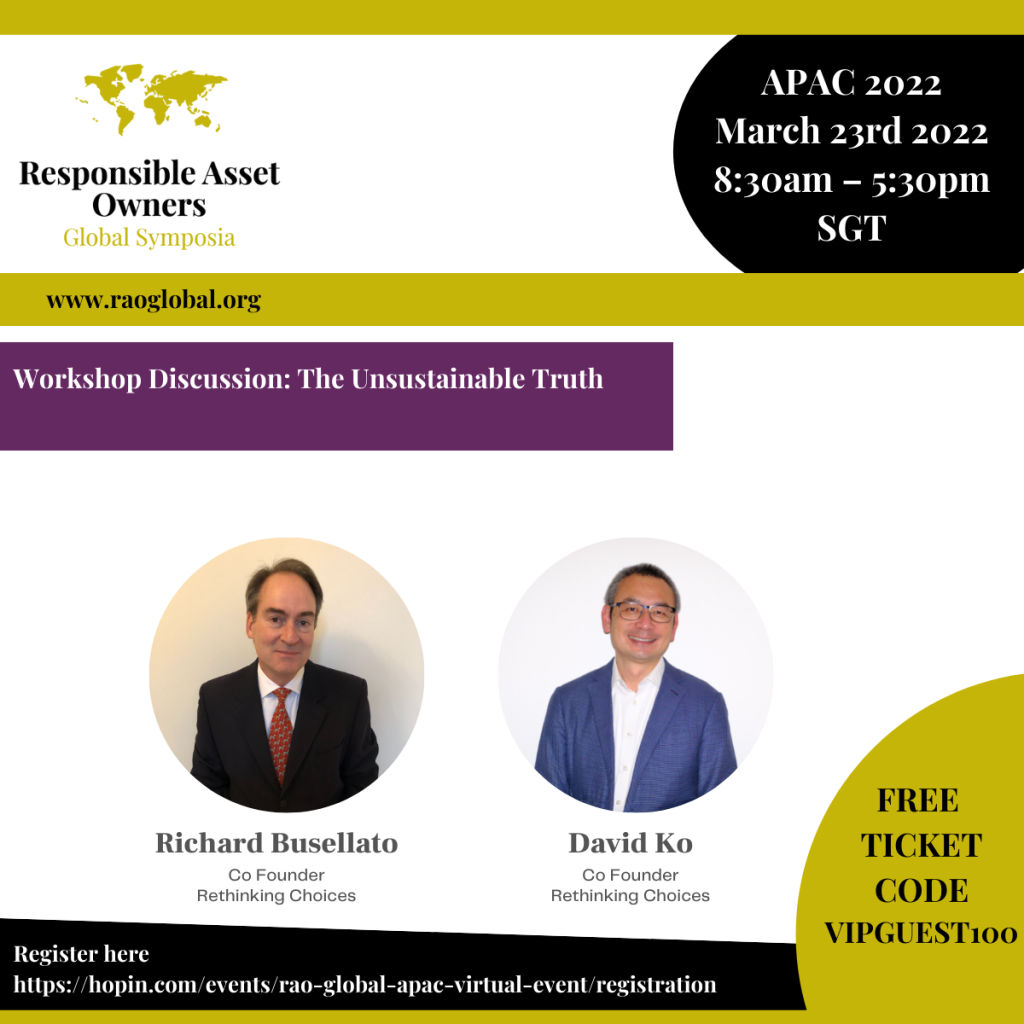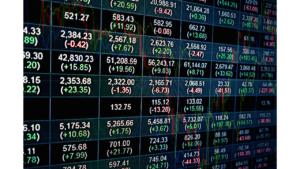Richard and I are preparing our talk for the Responsible Asset Owners Global Symposium on March 23rd. If you have a chance to register and attend, please do.

We are going to talk about the problems of investments we discussed in our book, The Unsustainable Truth.
Sustainable investments now make up over one-third of investment assets. Bloomberg reports by 2025, they are projected to amount to $53 trillion out of a total of $140 trillion in investment assets. The problem is we still use the same models of risk vs return that made investments financialise everything we do and create sustainability problems in the first place.
These ideas are based on things like the two-fund theorem or modern portfolio theory that are taught at colleges and MBA classes in finance and investments. They were developed by Nobel laureates like Harry Markowitz and Bill Sharpe who showed how different investment assets can be combined to get the best performance for a given tolerance for risk. This was at a time when the planet still had capacity. They help us to know when we are getting the return we should given the risk we are willing to take and led to the idea there is an efficient frontier. We like the word “efficient”, it sounds good. It helps us to think our portfolio is on target and we are getting the most out of the money we have invested. However, it presumes the planet always has the capacity to absorb our investments.
The models say that the more things we can invest in, the better we should expect the returns. This is because of what is called diversification. Unfortunately, this led us to invest in things like growing crops, making cars, building houses and the millions of other similar things we do principally for profit.
Sustainability is the latest of the things we are adding to the mix of things we do principally for profit to improve our investment return.
Unfortunately, the risks that go into working out the optimal portfolio and the efficient frontier are not the right risks.
Imagine the following. You live in a flat near a lovely garden. Kids go there to play, and others use it for exercise. It offers a bit of nature, a bit of peace and quiet for the hundred or so households in the three to four blocks of flats that surround it. Each evening on our way from work, we pause for a moment to collect ourselves before venturing that last step home.
One day, an idea comes to someone to hold a sustainability community event in it. It is a good idea and gets sponsorship from the company the person works for. The event will use no plastics, all the food will be vegan, and the invitations will specify all people attending must take public transport or walk to it.
The event proves to be an enormous success. Soon, the idea spreads and there are more such events providing education on how to be sustainable, promoting entrepreneurial ideas of sustainable innovations, and it becomes obvious that this is a good use of garden spaces and a movement starts – Gardens for Sustainability.
Slowly, as more events happen, kids stop using the gardens to play and people stop exercising in them. For ourselves, several evenings a week when we return home there are events that are happening and we no longer have that brief moment to recollect ourselves before joining our family. Even though the events are cleaned up rigorously after each, the cleaning removes the piles of twigs and half-decaying rubbish that actually help fungus and insects, and gradually we lose little bits of what we think of as imperfections that nature crucially needs.
When we express it in this way, it is clear these are the risks of holding these events. However, these risks may take decades to be recognised. At the time of the events, the risks that are recognised are simply that the events may fail. And that is the basic problem with treating sustainability in the same way as other investments.
Sustainability issues arise because we have come to realise that there are no longer sufficient resources to keep doing what we have been doing for a long time. It is not just that we have not priced correctly the cost of using the resources, but actually, we cannot use the same portfolio theories to decide how much return we should expect from our investments. These approaches ignore the fact that the costs may not be determinable until much later.
So let’s put this into a practical example. A share in Tesla is priced to be worth the same as about 170 years of current earnings. Tesla is in all the sustainability portfolios, and last year, it provided a 900% return on the amount allocated to it. It all seems that sustainable investing is a good way to make money and to save the planet.
The problem is at a price of 170 times the current earnings, it attracts more investments into electric cars and batteries. This is especially so when other people see how profitable the idea is and make more investments in it. This kind of feedback wrongly sees investment success as a signal for sustainability when in fact it does the opposite. Investment success leads to more activities, and ultimately to ignoring the planet’s limited capacity.
This kind of risk cannot be measured especially when the specific risk itself is not known at the moment. Our ideas of portfolio allocation and diversification are outdated. They are not suitable for a world where the aggregate size of investment assets is so large that investments easily exceed the planet’s capacity for activities.
This is a strong warning to anyone thinking about sustainable investing — Stop! Think! Can the planet really cope with all this investment money?



